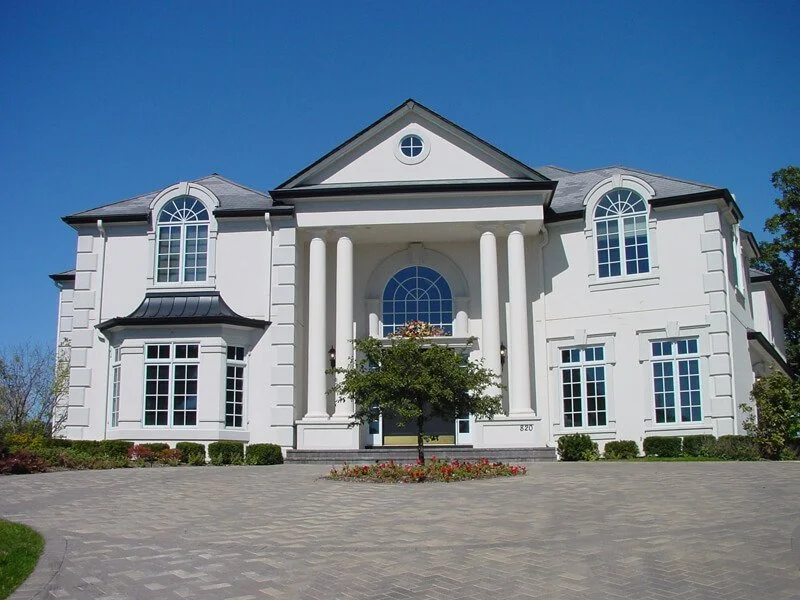How to Paint Fiberglass Columns
This article originally appeared on Royal Corinthian’s blog and has been reposted here with permission.
Choosing the "Right" Primer and Paint Combination
There are many considerations to make prior to painting your fiberglass column. You need to choose a primer/paint combination that works well together. We encourage you to talk to your local paint store expert or a professional painter to recommend a proper combination based on your particular environment and preferences: interior or exterior installation, anticipated foot traffic around installed columns, levels of humidity and light, sheen preference, budget, temperature at time of application, etc.
We have tested Sherwin Williams Extreme Bond interior/exterior bonding primer and Pro Industrial™ Multi-Surface Acrylic for the top coat, and the combination worked great on our products and in our environment. For an oil-based paint, we used the same primer and Sherwin Williams Industrial Enamel HS for the top coat. While we do mention a specific brand, primer, and paints, it is still encouraged to consult an expert as there is no way for us to predict every environment in which our columns will be installed. An expert who lives in your neighborhood and has been around the block so to speak is more suitable to recommend something.
Advances in the development of acrylic latex paints has resulted in many products that surpass the performance of oil-based paints and generally at a lower price point. We strongly encourage the acrylic option over the oil-based for reasons to come.
If you prefer architectural columns that don't require painting, consider our synthetic stone columns: It is a man-made stone product that looks and feels like stone but at a fraction of the weight and cost. These columns come with color pigment that fully permeates each particle of the product rather than an applied top coat.
Benefits of Sherwin Williams Extreme Bond Bonding Primer
Promotes adhesion of hard to paint surfaces
Bonds well to slick and glossy surfaces
Assures uniform appearance of topcoats
1 coat application
Quick dry
Universal, accepts Hi-performance coatings such as epoxies and urethanes
Benefits of Sherwin Williams Pro Industrial™ Multi-Surface Acrylic Latex Top Coat
Self-priming directly to multiple surfaces (we still recommend 1 coat of bonding primer)
Excellent one-coat hide and stain blocking
Great adhesion to slick and glossy surfaces
Abrasion resistant
Optimized for spray application
Good exterior color/gloss retention
Dries fast and dry falls in 10-15 feet
Suitable for use in USDA inspected facilities
The Advantages of Using Latex Paints on Fiberglass Columns
Latex paint is considered a water-based paint and those two terms are used interchangeably. It is comprised of synthetic polymers that resemble natural latex but there is no natural latex in these paints, making it yet another misnomer. Under this category of synthetic water-based paints, you have acrylics, vinyl acrylics, styrene acrylics, etc. Roughly 75% of paints sold today are latex because they offer significantly more advantages over oil-based alternatives. Generally speaking, the more acrylic there is in a latex paint, the better the quality, which is why we recommend the acrylic latex paint above from Sherwin Williams. The acrylic paint also has better color and gloss retention than the oil-based alternative.
General Advantages of Latex Paints:
Doesn't require a pre-treatment
Good mildew resistance
Low VOCs (low levels of toxic emissions)
Easy cleanup with water
Quick Drying
Elastic, flexible finish that resists cracking
Adheres to almost all surfaces
Stable color over time (doesn't fade or yellow)
Excellent water resistance
Superb weatherability
Excellent gloss, finish, and clarity
Smooth, even application
Little to no odor
Anti-corrosion and great alkali-resistance
Superior solubility
Due to the elastic nature of acrylic latex paints, they work well with our cast fiberglass columns. What most manufacturers omit or don't consider is that fiberglass columns have a higher expansion rate than concrete and other water-based materials. The columns expand and contract and so, naturally, the paint used should "breathe" with the columns.
Oil-based Paints and When to Use Them on Fiberglass Columns
The alkyd or oil-based topcoat that we tested from Sherwin Williams is highly durable and results in a rich finish. It is only available in a high gloss sheen. If you choose to use an alkyd paint on our fiberglass columns, you should limit the use to well-lit areas and areas that don't experience a wide range of temperatures.
Oil-based paint is known for emitting strong fumes and requires solvents like turpentine or paint thinner to clean up spills and used paintbrushes. These paints take longer to dry than water-based but offer good leveling and a hard durable finish. The major caveats to consider are:
Fiberglass columns expand and contract with changes in temperature so the hard finish of an oil-based paint is more likely to crack with expansion and contraction whereas acrylic latex paints are especially made to expand and contract with the materials under them.
Oil-based paints are known to fade and yellow and the yellowing can be exacerbated in areas with low levels of natural or artificial light as well as with exposure to ammonia. These articles speak to this acceleration as well as ways to slow/reverse the natural yellowing process of alkyd paints:
Alkyd paints are not environmentally friendly as they emit volatile organic compounds (VOCs) that are toxic. Exposure to these compounds can cause health problems so make sure to have adequate ventilation and a proper respirator mask to prevent being overcome by the fumes.
While we discuss an oil-based option, the negatives of this type of paint far outweigh the benefits. Oil based paints are good for high moisture and high traffic areas and result in a high gloss, durable finish that is easily cleaned, but you have to consider the adverse health risks, the yellowing and fading, longer dry times, the propensity to crack, and more. Instead of dealing with all of the nuances, might as well just go with an acrylic latex option and put your mind at ease.
Whatever paint you choose, always remember that there is no true economy in buying cheap paint so always buy the best quality paint that your budget allows. When choosing paint colors from paint chips or sample boards, remember that these colors will be more intense on the larger surface area of the columns.
How to Properly Paint a RoyalCast™ Fiberglass Column
Preparation: Follow the paint manufacturer's instructions concerning use within temperature ranges for best results. Allow proper dry time between all coats as instructed by the manufacturer. Wear proper protective clothing, gloves, masks, and eye protection at all times. Allow for proper ventilation when priming, painting, and sanding.
Sanding: The biggest mistake made when painting a fiberglass column is assuming that all manufacturers provide a fully sanded column. In fact, most manufacturers only sand the column seam and expect for you to sand the rest. If the column looks shiny rather than dull, it is safe to assume that sanding is required prior to priming. Use 80 grit sandpaper to sand the column.
Prepping the Cap and Base: Some manufacturers, in order to save on cost, will sell primed high density polyurethane or synthetic injection molded "SIM" capitals and bases with their fiberglass columns. Royal Corinthian doesn't do that for several reasons. Mixing materials is not a good idea as paint adheres differently to each material. Polyurethane bases can break with hard impact and SIM is a hollow plastic product. Our caps and bases are made from the same polymer marble composite material as the shaft. We have no recommendation as to the substitute materials but poly/marble caps/bases should be fully sanded as with the column shaft prior to priming.
Installation: If not already installed, install the column.
Cleaning Dust/Dirt: Clean all components with a damp cloth or a tack cloth. Areas with dirt might require washing with a solution of soap and water. Rinse off any soap and allow the column to dry. Do not spray the column with water prior to installation. Mineral spirits may be used but do not use acetone on fiberglass columns.
Caulking: Caulk the gap between the cap/base and the shaft using a high quality, acrylic latex sealant. Similarly, fill any screw holes or cavities (putty or bondo may be used instead). A silicone caulk can also be used but choose one that is paintable as most are not. If the gap between the cap/base and the shaft is too wide, a foam backer rod would keep the caulk from falling down. Let the caulk fully dry and apply more if needed prior to priming. Another option is to apply a non-paintable silicone caulk of the same color as the paint after all of the components are painted. Silicone caulk, due to its elastic and waterproof properties, is better suited for exterior applications. We have used MasterSeal NP-1 caulk with our products for well over a decade if not two. It is a polyurethane sealant that is compatible with non-rigid coatings and can be painted (not with oil-based paints in other words). It comes in many colors so it can also be applied after the column is painted. We recommend it for our synthetic stone columns and balustrades as well.
Priming: Prime the column using a 3" paintbrush, a roller, or spray it on. Most tend to recommend the brush method but consult the primer manufacturer's recommendation for best application. The primer that we have recommended can be applied using any of the three methods. Select your primer based on the location of your columns (exterior or interior) as well as the type of paint that you will be using (latex or oil based) and (flat or gloss or in between). Your paint store expert should be able to recommend the ideal primer/paint combination based on your particular factors. A good rule of thumb is to use the same kind of primer as the paint and from the same manufacturer.
Sanding the Primer: In testing the Sherwin Williams bonding primer, we did not have to sand the primer after it dried. Some manufacturers recommend sanding their primer prior to applying the top coat to remove irregularities and insure a smooth final finish. Use the manufacturers recommended procedures if sanding is required. In general, use 220 grit sandpaper to lightly sand the primer coat. Use a rag soaked in denatured alcohol or a tack cloth to remove the sanding dust.
Applying the Top Coat: Once the primer has dried in accordance to the manufacturer's guidelines, begin applying the top coat from top to bottom of the column. Let dry.
Applying a 2nd Top Coat: The acrylic latex and oil based options that we tested were finished with a 2nd top coat with no sanding in between. If your chosen paint requires an additional top coat, follow the manufacturer's guidelines. Sand between coats if recommended or needed and clean off the dust as before. Generally, if needed, 400 grit sandpaper would be used to sand the first top coat.
For more information on columns such as how to replace them, and the difference between column covers and wraps, be sure to check out Royal Corinthian’s blog.
Royal Corinthian manufactures 3 types of fiberglass columns. Our RoyalCast™ fiberglass columns are the most popular; they are available in every style that we offer and are made from the most widely used composition in the market. It's actually a misnomer used by the entire industry as these types of fiberglass columns contain a very small percentage of fiberglass strand as compared to our other options. A more accurate name would be polymer marble or poly/marble composite columns but we will stick to what the industry has called them for decades. These cast fiberglass columns come in a grayish, grayish blue, yellowish, or brownish color depending on the filler used by the manufacturer and are considered a paint-grade product. All of our fiberglass columns come with a lifetime warranty.





